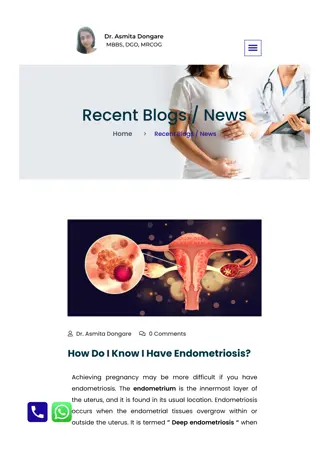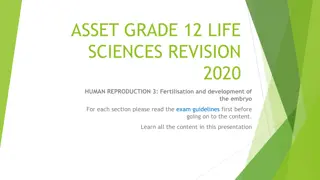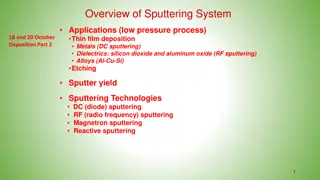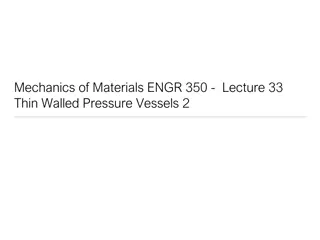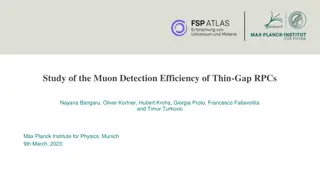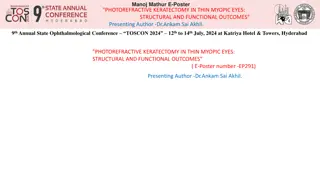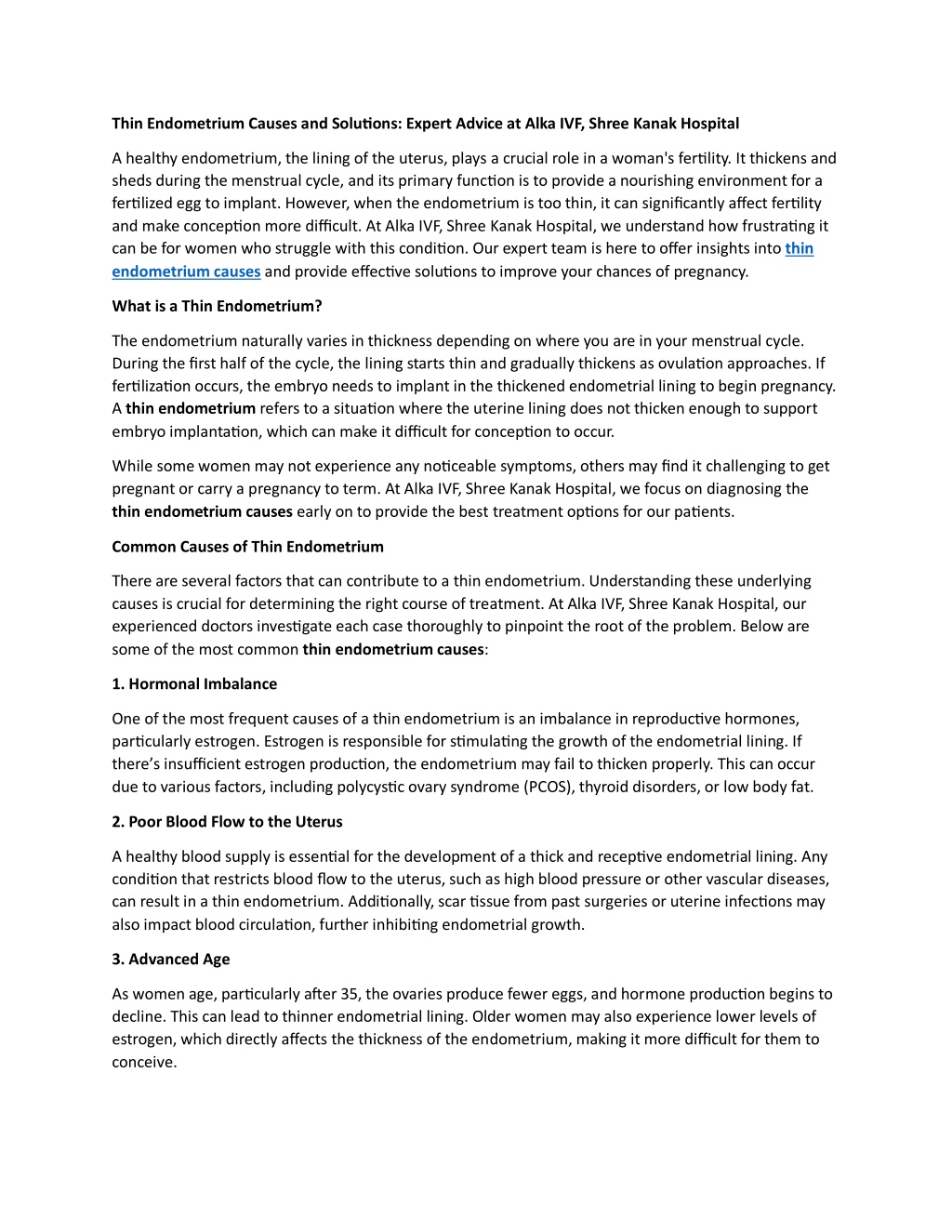
Thin Endometrium Causes and Solutions 19 nov.
thin endometrium causes
Download Presentation

Please find below an Image/Link to download the presentation.
The content on the website is provided AS IS for your information and personal use only. It may not be sold, licensed, or shared on other websites without obtaining consent from the author. Download presentation by click this link. If you encounter any issues during the download, it is possible that the publisher has removed the file from their server.
E N D
Presentation Transcript
Thin Endometrium Causes and Solutions: Expert Advice at Alka IVF, Shree Kanak Hospital A healthy endometrium, the lining of the uterus, plays a crucial role in a woman's fertility. It thickens and sheds during the menstrual cycle, and its primary function is to provide a nourishing environment for a fertilized egg to implant. However, when the endometrium is too thin, it can significantly affect fertility and make conception more difficult. At Alka IVF, Shree Kanak Hospital, we understand how frustrating it can be for women who struggle with this condition. Our expert team is here to offer insights into thin endometrium causes and provide effective solutions to improve your chances of pregnancy. What is a Thin Endometrium? The endometrium naturally varies in thickness depending on where you are in your menstrual cycle. During the first half of the cycle, the lining starts thin and gradually thickens as ovulation approaches. If fertilization occurs, the embryo needs to implant in the thickened endometrial lining to begin pregnancy. A thin endometrium refers to a situation where the uterine lining does not thicken enough to support embryo implantation, which can make it difficult for conception to occur. While some women may not experience any noticeable symptoms, others may find it challenging to get pregnant or carry a pregnancy to term. At Alka IVF, Shree Kanak Hospital, we focus on diagnosing the thin endometrium causes early on to provide the best treatment options for our patients. Common Causes of Thin Endometrium There are several factors that can contribute to a thin endometrium. Understanding these underlying causes is crucial for determining the right course of treatment. At Alka IVF, Shree Kanak Hospital, our experienced doctors investigate each case thoroughly to pinpoint the root of the problem. Below are some of the most common thin endometrium causes: 1. Hormonal Imbalance One of the most frequent causes of a thin endometrium is an imbalance in reproductive hormones, particularly estrogen. Estrogen is responsible for stimulating the growth of the endometrial lining. If there s insufficient estrogen production, the endometrium may fail to thicken properly. This can occur due to various factors, including polycystic ovary syndrome (PCOS), thyroid disorders, or low body fat. 2. Poor Blood Flow to the Uterus A healthy blood supply is essential for the development of a thick and receptive endometrial lining. Any condition that restricts blood flow to the uterus, such as high blood pressure or other vascular diseases, can result in a thin endometrium. Additionally, scar tissue from past surgeries or uterine infections may also impact blood circulation, further inhibiting endometrial growth. 3. Advanced Age As women age, particularly after 35, the ovaries produce fewer eggs, and hormone production begins to decline. This can lead to thinner endometrial lining. Older women may also experience lower levels of estrogen, which directly affects the thickness of the endometrium, making it more difficult for them to conceive.
4. Previous Surgeries or Scarring Women who have had surgeries on the uterus, such as D&C (dilation and curettage), cesarean sections, or myomectomies (fibroid removal), may experience uterine scarring or adhesions. These conditions can prevent the endometrial lining from growing to its full potential, resulting in a thinner lining. It s crucial to consult with a fertility expert at Alka IVF, Shree Kanak Hospital to evaluate whether past procedures are affecting the thickness of your endometrium. 5. Lifestyle Factors Lifestyle factors such as poor diet, excessive exercise, stress, or being underweight can also contribute to hormonal imbalances and poor blood flow, both of which affect endometrial health. Women who are significantly underweight may have lower estrogen levels, which can hinder the endometrial lining's ability to grow and develop properly. 6. Endometrial Disorders Certain conditions, such as Asherman s syndrome or endometrial hypoplasia, can directly affect the growth of the endometrial lining. Asherman s syndrome is characterized by scar tissue formation in the uterus, which can make the lining thin and less receptive. These disorders often require specialized treatment to restore the normal function of the uterus. Solutions for Thin Endometrium At Alka IVF, Shree Kanak Hospital, we offer several solutions to address the thin endometrium causes and help improve the chances of conception. Treatment is individualized based on the underlying cause of the condition, and our team of experts is dedicated to providing personalized care. 1. Hormonal Therapy If hormonal imbalance is the primary cause of a thin endometrium, the doctor may recommend estrogen therapy. Estrogen can help stimulate the growth of the uterine lining, making it thicker and more receptive for implantation. Progesterone may also be prescribed to support a healthy pregnancy after implantation. 2. Increased Blood Flow In cases where blood flow is compromised, therapies like low-dose aspirin, sildenafil (Viagra), or heparin can be prescribed to improve circulation to the uterus. These treatments can enhance the endometrial lining's ability to grow and maintain its thickness. 3. Platelet-Rich Plasma (PRP) Therapy Platelet-rich plasma (PRP) therapy is an innovative treatment that has shown promising results in enhancing the thickness of the endometrium. PRP involves using the patient s own blood, which is processed to extract platelets, and then injected into the uterine lining to stimulate growth. This therapy has been used with success for patients experiencing unexplained infertility due to thin endometrial lining.
4. Surgical Treatment for Scarring If scar tissue or adhesions are present, a hysteroscopic procedure can be performed to remove the scar tissue and help restore normal uterine function. This can improve blood flow and allow the endometrial lining to grow properly. 5. Lifestyle Modifications Maintaining a healthy weight, eating a balanced diet rich in vitamins and minerals, and reducing stress can all contribute to improving hormonal balance and overall uterine health. Our experts at Alka IVF, Shree Kanak Hospital also advise women to maintain a healthy lifestyle to optimize fertility. Conclusion A thin endometrium can be a significant barrier to conception, but with early diagnosis and appropriate treatment, the chances of a successful pregnancy can be greatly improved. At Alka IVF, Shree Kanak Hospital, we are committed to providing the best care for women struggling with thin endometrium causes. Our team of specialists works closely with patients to determine the root cause and create a tailored treatment plan to enhance endometrial health and fertility. If you're struggling with a thin endometrium or any fertility-related concerns, don't hesitate to consult with our experts and take the first step toward achieving your dreams of motherhood.



